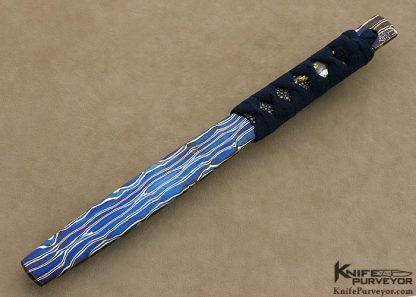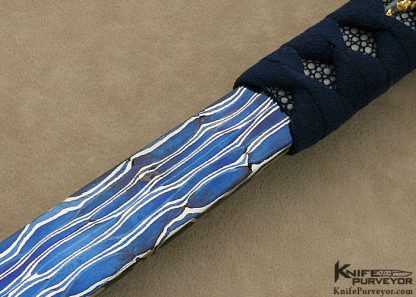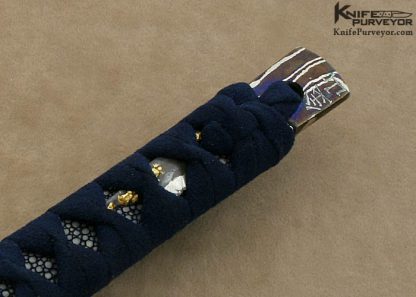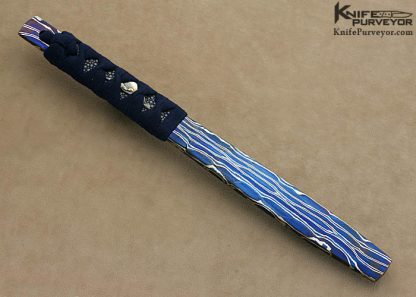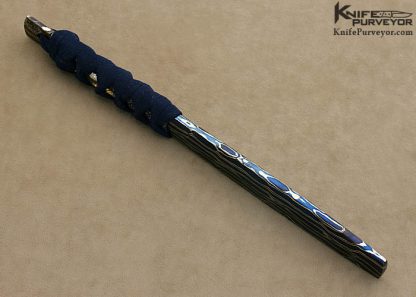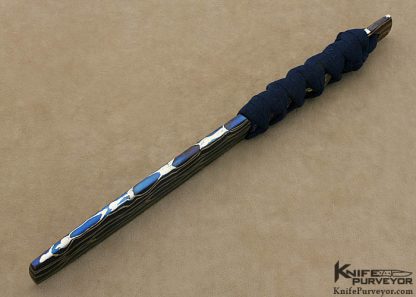David Goldberg Custom Japanese War Fan “Tessen” Sole Authorship Blued Damascus
"Fuji-san Tessen" English; Fuji Mountain Iron Fan
Here is a Unique piece made by master Japanese sword smith David Goldberg, AKA Kinzan.
Kinzan follows very closely to the traditions of Japanese warrior weapons. He adheres to strict line form and geometry. There were many variations of weaponry based on use, need, purpose, and school of training. The last element in variation was the artist. In Japan, there was a stringent guideline as to what was allowed as far as how a given weapon was made. Swords had to be made a certain way. The ornaments on the sword had to be placed in a specific place and way. However on tanto (knives) and smaller personal weapons such as Tessen, (Iron Fan), a Samurai had more freedom. An armorer or sword maker could take artist license within classical form. In todays western world artists are only confined by clients desire, the size of the purse, their own artistic imagination and skill.
Tessen were folding fans with outer spokes made of heavy plates of iron which were designed to look like normal, harmless folding fans or solid clubs shaped to look like a closed fan. Samurai could take these to places where swords or other overt weapons were not allowed, and some swordsmanship schools included training in the use of the tessen as a weapon. The tessen was also used for fending off arrows and darts, as a throwing weapon, and as an aid in swimming.
Tessenjutsu is the martial art of the Japanese war fan (tessen). It is based on the use of the solid iron fan or the folding iron fan, which usually had eight or ten wood or iron ribs. The use of the war fan in combat is mentioned in early Japanese legends. For example, Yoshitsune, a hero of Japanese legend, is said to have defeated an opponent named Benkei by parrying the blows of his opponent's spear with an iron fan. This use of the iron fan was taught to him by a mythological creature, a tengu, who also had instructed him in the art of swordsmanship.
The practitioners of tessenjutsu could acquire a high level of skill. Some became so skilled, in fact, that they were able to defend themselves against an attacker wielding a sword, and even kill an opponent with a single blow. Like so many other Japanese arts of combat during this era, tessenjutsu reached a high level of sophistication. For example, a famous swordsman in the late 16th century, Ganryu, was able to defeat several enemies with an iron fan.
Apart from using it in duels against enemies armed with swords and spears, the skilled wielder could also use it to fence and fend off knives and poisoned darts thrown at him. Like a sword, the tessen could be dual-wielded to parry with one hand and attack with the other.
Tessenjutsu is still practiced by a few experts in Japan to this day. Kinzan makes several varieties of tessen. This is the first one we are offering on Knifepurveyor.com.
In this piece, Kinzan made the solid club type tessen shaped like a closed fan. It is hand forged and fabricated from a piece of Mosaic Damascus in a Japanese silk fabric pattern.
This steel consists of pure nickel and high carbon steel. The steel has been polished and blued. The handle is covered in file back blue genuine stingray skin, wrapped with blue suede. The handle ornament is a patinaed, solid sterling silver menuki in Mt. Fuji motif.
| Knife Maker | David Goldberg |
|---|---|
| Blade Length | 6 5/16" |
| Overall Length | 11" |
| Weight | 11.8 oz |
| Blade Material | Blued Sole Authorship Damascus |
| Scale Material | Stingray Skin Wrapped with Blue Suede |
| Condition | Light Wear |

